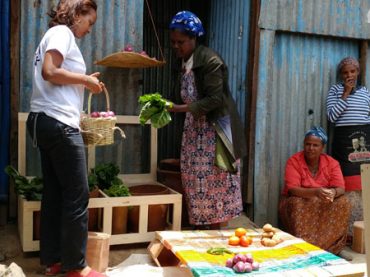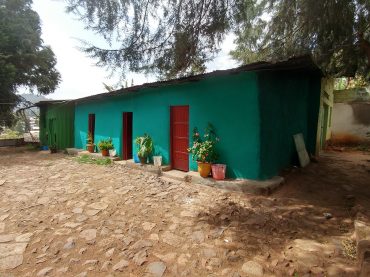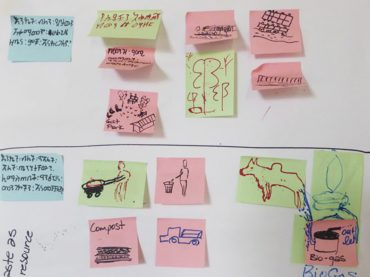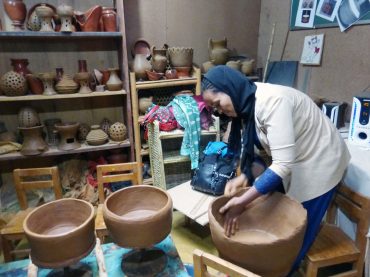Clay 16°

Before the team began working in Rwanda and Agoza Market, the group ran a workshop with students from the Ethiopian Institute of Architecture, Building Construction and City Development (EiABC). The intensive 8 day workshop explored the architectural possibilities of gulit market stalls and cooling strategies using clay.
Clay 16°
The ‘gulit’ is the typical local fruits and vegetable market place of Addis Ababa.
It consists of a series of small stalls, each used by a single vendor to sell their food items. These stalls are usually made out of basic metal sheds, and are not equipped with basic infrastructure including water and electricity. The materials used to store the food items inside the stalls are mostly plastic and inorganic.
This particularity has the consequence on the market: the inappropriate storage of organic matter results in food loss through short shelf life – and what does not get sold during the day gets thrown away. This results in avoidable waste and economic loss and forces local vendors to buy from wholesalers on a daily basis,
Clay 16° was a workshop – part of a bigger research/innovation project on designing and building sustainable system of food storage, in turn adding value to small scale vendors, while improving the quality and health of their produce.
It was conducted at the Ethiopian Institute of Architecture, Building Construction and City Development (EiABC). It aims to provide an alternative stall constructed out of double-layered pots made out of clay. They will be geometrically placed as to define space at the same time creating a passive cold storage system throughout the gulit.
The double layered clay pot functions as an evaporative cooling system. Inspired from a zeer pot – an evaporative cooling refrigeration device, traditionally used in West Africa and the Middle East- it is made of two layers of clay with a sand and water filled cavity in the middle. The outer layer of the pot, exposed to hot dry air sweats water which in turn evaporates and provokes a heat exchange, cooling down the inner layer. The inner chamber of the pot can be used as food storage reach lower temperatures than the ambient air.
During the course of the workshop, a 1:1 empirical test produced a drop in 10ºC. The outer temperature being 26 ºC and the one recorded inside the pot 16 ºC, which is ideal for vegetables.
Clay is a material that has been used to: cool water; carry seeds; protect people from weather; and to preserve food. The proposed module introduces its contemporary approach and design to improve the culture of food preservation in Addis Ababa. During the course of the workshop, collaboration was set between EiABC and a local women’s crafts cooperative dedicated to clay based products who worked with participants to produce the double layered pots.
Each pot consists of double spheres which are approximately 45 cm in diameter. The spherical geometry enables them to be stacked one on the other to compose a structurally stable assembly. The geometry of the pots minimizes contact between one another improving their contact to the atmospheric air, necessary for the cooling.
The pots are connected by a rope woven on each pot: facilitating the assembly; ensuring its structural stability; and providing a water channel in between each pot. Six vertical layers of pots make a 2.4 high wall.
Stacking the pots has multiple advantages: the wall will be easy to construct and because of its modularity, it can always grow. The top pots will be watered on a daily basis and gravity will enable the distribution of the water through the entire wall system in turn optimizing water usage.
The Clay 16° wall is a modular design, which can be developed over a period of time. Each module will be affordable and available for purchase to the local vendors and market community.
—
Workshop promoter and location:
EiABC (Ethiopian Institute of Architecture, Building Construction and City Development). Addis Ababa, Ethiopia.
Dates:
30/12/15 to 7/1/16
Workshop directors:
Melat Assefa, Edouard Cabay, Andrea di Stefano, Julia Mauser.
Students:
Hamdia Abdusemed, Abenezer Abebe, Dawit Addisu, Semira Alemseged, Yeabsira Asmare, Kidus Belayneh, Frezer Birhan, Michael Desalegn, Yohannes G/Medhin, Selamab Getachew, Leul Hailemichael, Esayas Kebede, Dawit Kehase, Orion Lemma, Selome Mekbib, Emaelaf Tebikew, Kidus Tekeste, Kalkidan Tesfaye, Amen Wakgari, Bruk Worku, Henok Yared, Tofik Yesuf, Mezgana Yihdego, Natnael Yohannes, Bezawit Zerayacob.





















